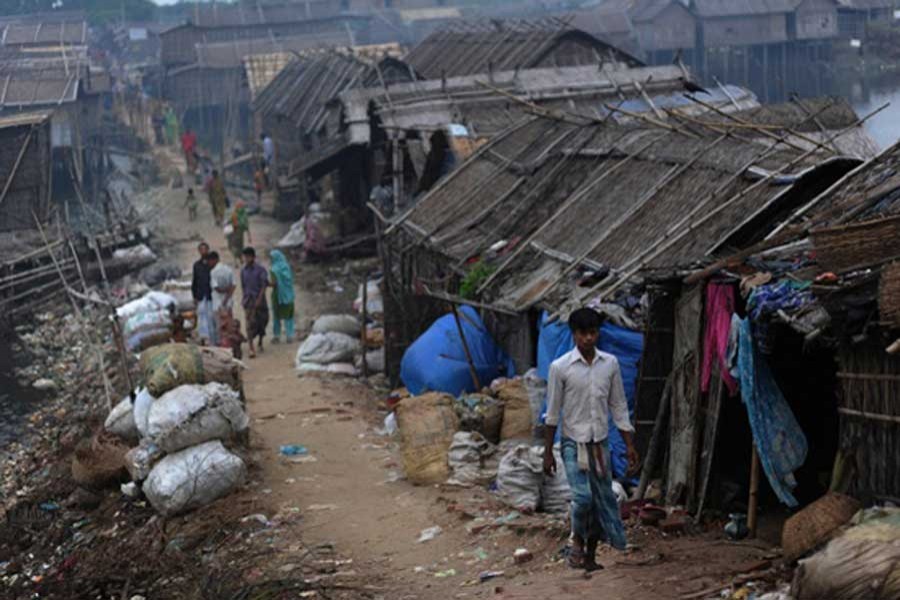Belying the apprehension of virologists, epidemiologists and public health experts, the slums in the capital seem to have defied coronavirus quite well. Other major cities also have not reported any alarming sign of the disease's impact on their slums. Since the detection of the first Covid-19 case on March 8 last, about five months have passed.
It is the residential areas of the capital and other cities that have reported exponential spike of transmissions -in some areas at frightening rates. Not that the posh areas were less affected than the more crowded localities. People living in enviably high society with the best possible amenities and care at hand were not spared. In terms of death and spread of the disease class disparities starting from lower middle class to the elite did not prove much of a factor.
Strangely enough, the slums where every ingredient of contagion of a disease like Covid-19 is present have so far apparently witnessed no such virus attack. That those bustling but miserable urban settlements made hardly any news for the virus except for fires that devastated a few during this time is proof enough of how slums have been spared by the pandemic.
A Bangla contemporary has reported that in slums like Karail Bosti, Mohakhali Sattola Bosti, Mirpur Beguntila Bosti and Kalyanpur Pora Bosti there are more or less 30,000 shanties in each of them with about 0.2 million inhabitants. The passages in between two rows of shanties are too narrow for crossing two persons at ease. What is even more inviting for the virus to establish its reign there is the huddling of five to eight people in just one congested room. For seven to eight such shanties, there is just one common toilet, a kitchen and a bathroom.
With such meagre provisions and deplorable conditions, there is no question of maintaining physical distancing let alone other health protocols. They do not even wear face masks because they are struggling to manage food and have no money to spare for such masks. Many of them are unemployed and are unlikely to have regular hand wash. Have they developed herd immunity? They assemble for regular gossiping as before at tea stalls located in their slums. The impression is that there is no pandemic anywhere -so normal a life they lead in the area.
What is the mystery behind the virus staying shy of the most inviting condition for its proliferation? The International Centre for Diarrhoeal Diseases Research, Bangladesh (ICDDRB), the Directorate General of Health Services (DGHS) and Mugda Hospital have reportedly been studying why slum-dwellers and low-income people are less prone to the virus's attack.
Some experts argue that slum people also catch the virus but due to their greater immunity the disease is considered a common cold. Tablets like paracetamols used for treating fever cure them. Even if the first part of their argument may have some grounds, the second part looks completely untenable. Either they are fully immune to the virus or they develop common flu and fever which tablets like paracetamols can cure.
In that case, the other expert opinion looks more tenable. This version of the argument is that these people toil so hard and get so much of the sunshine and rains that their heightened immunity is too much for the novel coronavirus. But this argument is not without flaws if the presence of the disease in similar settings and conditions is found not uncommon. In Mumbai's Dharavi slum, the largest in Asia, although the disease has been contained by draconian measures, still both infections and deaths could not be avoided. The number of death rose to 80 in total by the third week of June and the average doubling rate had reached from 18 days in April to 78 days by that time.
In the same breath, the cases of Singapore can be cited here. In taming the incidence of coronavirus attacks that island country was quite successful but its spread was on a large scale among immigrants including those from Bangladesh, who are used to living in crammed conditions. Such migrant workers also have to work hard and are not deprived of bounties of natural environment except when they huddle into their hovels. There they live in comparatively better conditions than their compatriots in slums of Bangladesh.
Arguments on immunity status of slum-dwellers may vary but there is one unanimous agreement that admission of patients from slums is next to nothing. That is the strongest argument in favour of slum-dwellers' enviable immunity.
In this context, the pandemic's near absence in villages of Bangladesh can be a confirmation of the virus's powerlessness against the immunity of people living in natural settings and allowing them to be exposed to fresh air, abundant sunshine and even unwelcome excessive rains at times. Villagers have even claimed that a few returnees with corona symptoms from cities even recovered from the ailment without treatment. Such claims and counterclaims cannot be substantiated unless extensive studies are carried on the spread or non-spread of the disease in different settings. Let the ICCDDRB and its partners gear up the pace of the study in order to come to an acceptable conclusion.


